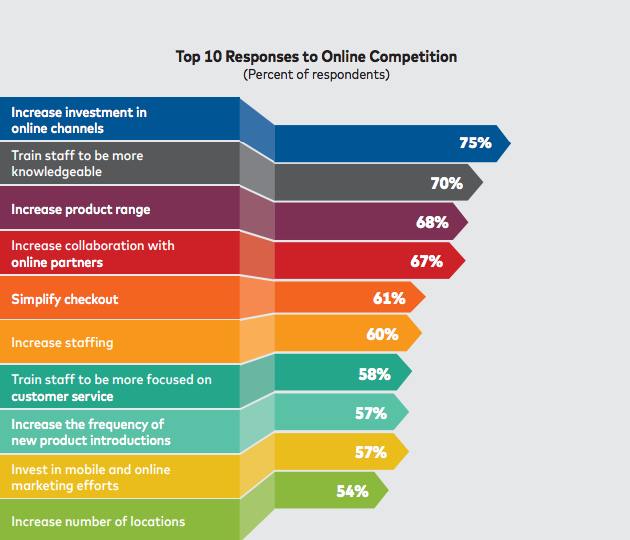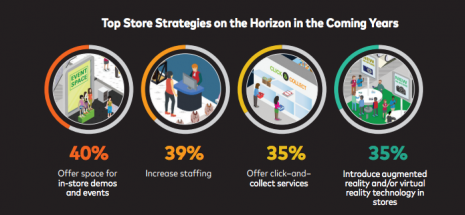The disruption of online shopping has greatly impacted bricks-and-mortar, but physical retailers are fighting to stay alive with an arsenal of digital and tangible tactics to safeguard their industry.
It is no secret that bricks-and-mortar has been suffering with more stores having to close their doors within the past few years. But a new report from Applied Predictive Technologies (APT) shows that 75 percent of retailers are increasing their investments in online.
"Everyone knows that traditional retailers are facing significant competition from online-only players," said Jonathan Marek, senior vice president at APT, San Francisco. "Yet, the report demonstrates that in response to this challenge, retailers are reinvigorating the bricks-and-mortar experience through innovation.
"As one example, findings show that retailers are focused on minimizing the competitive advantage of online-only retailers in key areas such as assortment and price by expanding their own product selection (68 percent) and cutting prices (44 percent)," he said. "Additionally, there is an increasing focus on customer analytics."
Digital and bricks-and-mortar
In the report, it is noted that 60 percent of retailers have had to shut down bricks-and-mortar stores worldwide within the past three years.
Online is now vital to the future of retailers, and has long ago surpassed simply an added “cool” tool. Retailers need to find interesting ways to embrace digital to stay afloat.

Graph showing survey respondents' responses provided by APT
Personalization and endless information are now available to consumers through every portal online. Customers are now armed with more information at their fingertips than store associates.
Retailers are catching on to this and that their employees need to be more knowledgeable. Now, almost 70 percent of retailers have invested in making employees informed.
This is the most popular way retailers are hoping to strengthen bricks-and-mortar. Retailers who are growing their inventory to help made up 60 percent of the research.
Loyalty programs are becoming another weapon in bricks-and-mortar’s arsenal with 54 introducing them and 24 percent planning to do so soon.
Price cuts have also proved helpful to those who have closed stores, with 72 percent of those who stayed afloat after closures implementing discounts.
Scientific testing can be extremely influential in the retail industry and has already made an impact, with 60 percent of stores who use this method to test out new ideas having either circumvented store closures or recouped sales from closed stores.

Inforgraphic of top store strategies in the future provided by APT
In the future, retailers are likely to start offering more in-store events, increasing staff, beginning in-store pickup programs and using more augmented and virtual reality in stores.
"Fifty-four percent of U.S. respondents have already introduced more detailed customer segmentation or analytics, and another 28 percent plan to," APT's Mr. Marek said. "Further, 39 percent have already introduced the ability to track individual customers’ activity across channels, and another 41 percent plan to.
"This suggests that retailers are recognizing the importance of having customer-centric strategies, and that they are developing the customer-centric analytic capabilities to match," he said.
Additional insight
Amazon and online shopping experiences continue to threaten bricks-and-mortar, with the number of store closings in the first half of this year outnumbering all of those that closed last year.
Many retailers are relying on discounts instead of sporadically offering them throughout the year for holidays and events to help attract shoppers in today’s tumultuous retail environment. However, ecommerce is continuing to move forward with sales in the first quarter increasing by 15 percent year-over-year (see more).
Apparel and accessories brands need to progress much further in an omnichannel strategy, as millennials’ shopping experience spans a multitude of channels, starting online for product discovery and ending with purchasing on any given platform.
According to the new Criteo Apparel Trend Report, millennials are now more omnichannel than ever, looking up product information and trends on social and online, but any on whichever platform they choose. Retailers and brands need to close the gap between these platforms and focus on an experience that spans all channels (see more).
"Although new in-store technologies are on the rise, the most common in-store response to online competition globally is to train employees to be more knowledgeable," APT's Mr. Marek said. "In the U.S., retailers have also focused on enhancing the in-store customer experience through the advantage of face-to-face customer interaction.
"In particular, 75 percent of U.S. respondents have already trained staff to be more knowledgeable, and 61 percent have trained staff to be more focused on customer service," he said. "In retail, investing in staff training has always been an important ingredient in the recipe for a successful business, but with the rise of ecommerce, high-quality customer service is a critical differentiator for the in-store experience.
"Given that, for retailers today, optimizing personnel decisions and human resources investments is integral to developing a competitive edge."
{"ct":"2ECCbQwxxUKJ8XEwgaZqyYhUhvelpVEzZR\/4syLmyzoBjw+z+FLnuNkkT3+MHPUTnP+6mzZyDPA7Jgj8AIo9f5cJxLjgMkbD0asEs2hR\/4sOxPY1ue26yK9ErTv5eI7i2XBXFalOFjX9HjY9Fr2EleruoIVQPl42lT6Ik89uRvrnpGyCRy9crjpUalHiAmuU39DIYuxkoIiswyV1fL\/G\/2X5X3yDtwNHC0ezj2nFULAn1iXk\/C6dDkHz9q19Nweeid3FWMZ+cBeHmoRT469hxFMeRJZ01Nwn1FkR6QyPYQNA8ffuA6itrQPdx2QA8WQrCDt3XVpUtHWuLYvbnayz\/OvSpDpKnlWXHO6IsSdxW7IVeCyZKTZDBSD4+navFAEGKzZE+\/mWIFrBGreOu\/hp3jSrekiRTSTcMcfY9UMnSr0N9Www8UanCF6CJ4WnU6OEhOfXlUmmMH68IrbCK4p+th\/6jh\/7dzFVcNaZY4VDHlzjjClB1XLVv81v5ciLyRmgsuieYtGM8i0SPkhoiKaPokb46pWk1kD91DuvrTEvU7oX7gn58Z7ObI0fygf3fcojh6kuSs3cHrWSk3KIhFAjfup4PyMM\/6O7uKe9rozGyTyEJbQ2KUX+tGVUjTacS\/cv2OzMZW7zqZ6N4Yxf3\/OXlHh0+37GuTgUZ7QEDQS+eWz9wBVleHcH6rhstr80MIK+iWGAJ3FLbmRiEwymcYOuWumJpFeQUCWsrmMHqW44eefk+sEU8W3XL2O37Fvm0wyPcRVS+WNc1QtJ7x\/GqGkkfAxPbnZSaUaZazW4XSCTkNo6Cjii\/GY+exhPIPsfkZTCEtCdVgnQfKSdTW5DClj6RnQ10QstA4u6murp6LheZRAh4OYn1wg884H83YUAlFYer2dDPkz1HHxizCmmtwOfYXsVjHvuWkR11e79ol403N2Lqkbra40nE0njClOkCdRzt6RwqNvUN1ZdoR4wYXXAFsjDoJFvQ62nHisKXh+H4nePk+DAtEOW42tw1QVaeqGy3QJ5MRh+4VwGEP2+p6i8njKolTnQmSSPT1utQ50YUL5\/Cu+pY+PmRwucRgPj1jif23TYBgZk0lDFeesE2L9cPsHtloPBGQNbfRzJrcANu2ur6vEdf1yP50cMm0oS68n1ueHBxONXXkgeMZKayI+vdfxVfcpRPCNewynUUMmC+CJPvoIdym\/chNoqrwWDktQSHWLE1FxJi\/4BZXA1pPkLARi+I2n3sMoAxGARi+54tkQ4IQUIPRTjR93JUyfjfF\/AqBCHY2qLbvHBIm4nFhsd7Uou+yz7RmKzBgShs2p1qfMNnlMYfC9m0CkuK\/LXLhbCypbkdk4ZZExxwRDBts4FM5vtSpA0kAPiriHBcPrFD+y7LeRQHbOEpY0+pdi5UBlAUNaSgf91f7amqneTinKQE0vC3wr5hlSq6QXgGqVTu4Y87SSCRGe1euh+6nLGndknYWX5RRoXv\/ZXTbI3\/Jk9zEOi4zJdVMTUm25OHZgU5yZSVzgVV7T8K8FYS4gW1kYWpCwPtc3JT+xMXhB0Ici4eKwqcnJxix5VF7KsWrn2HgQpS4rzQc8XcDupvIJj9GLBVMjnOoueC1vjoRC8nviLzjszTHN9PNATjGZfD0lxmfjIkk4adp385eKbStyZr1X9zkZHe\/cZ805lkAWWNoxnCaD2Q2kfSbR8+HQeKkZ3qhECBZqQ0fR+vsvhE6dlQ5m\/GaVBXYk0MQOvaiEab6zcxgIFs0xCHE5aUMkhjDpS2J\/mlJZgK6oLnWvbGNQHBUFlARoMa3EIW+VKH4\/r1yhJeneW7YgmcpK3K778t4W47Tic\/1F6q5qKNiWdflIkmEFrg6Jz6qiq07Q4J1jqgbAIwMYuku3wJkNRomvZuZRz5t0CvuPJN8aHoa2KijLCYcP1J3akxc58\/lVK8xktCw4ifo0vnyjXDiUaQCDzlh7t3OHAOj+WC1n5hg8oBcTUGbgLl+69jAcm2KZqCTIVr20G9NOQjKjSqStiRZVuCERsxuVsZpek2yv7vRTl2iULZPrhyYESoEjlBh8CWRQ7f0qa5RFwmIfm1Sladi35e2L7Djcwt5H7HE52UUk+KDqmhaJV718GkFKCN\/JmF8GB8R6QPvlehMJ4ZrdQx5uGh\/6TJHCgwULqexWeKESbyzMoPq1E0j539RyAzFqSrUmcpv+oK2TeQMMvyvUTdUAd2rGDqedxgqkSmA3m17hTMJsx\/YkPCHfxVzjUQjoX3EoU95fawKQBvDMDq2xYPNLIihQAxvueB4pKAx\/31f5XI1p+j4JwYnieoWXQ0mKCbds9Tj13oIbsQ0ye1bKzMy0m6w4i584suI1EI62K1MeAcudKiTi5S\/lXSBbaVStDBdRTj3BMJGPez+rfpuyEf6I3M2qk2aWKhjZVuuXH2JOYQvOmIdToDesPwh8pN\/Cnu5SLMZJn+N1cOTEuERsY\/6W4mblH82OIb0SzkhMgLyO+EZrxxauImBIc5qhe9HH+QI56ltTBRLUWObEKWxHMyRQp1wa+D\/sQCCTF4IDhX1OwaLaZTytUQ7zdJ+MD86iS8EjrkcCG3\/NZo\/CtDk9QuDSJr4aC4eB8HW1Gl3o3bPDZmIITDlGlI6aU39wmJE\/rA0uvCq9POYD9KLsM\/GmYcUcw+yyZHZJaxSMv3iARrSmdF8CIrkDQrrBV\/b0SpQtxRr1IxPTmPVUEoZCFVrI+nco6w1A\/8GkbdQycFz85xhsnRnEw3B9UjlvJlVv7ba25NaFueybRZTQqjfA7Gd3\/7Y010BLXr9b1X9gLe+7gsi3ojIweTiNaxPf3J69CJiG+t0Zl37iSm1N2jFBHlvRdHJjHlcBHO\/Vdjw254y9aabovZhYVSdGK0fE\/APQJTnDm25BpAOEiqnH+V6ZLdoLWWgaIeAE\/3sdC525Sx+Xfc7GSxfDXSRA7XGQ5OAVHd3NSSuhuB\/zr8dMoy\/CTePKy+J5XWP+MAG387LzwmqyI\/P9DnuY7IytkiDVyl\/uNfA9\/2ymxTo8USF8IaOOXPOSuJjFMHmMJHDNfFhdeVSuABVG04enCBy6Sm1gshITwIds6wtADuvPhXM1ibuUJ4mlSqo0rEpividn9h0oyzRZIGr2ydx8nzC+r4L6JV5b0e3qAgQsQ70GjvCDaJpXddkgZKPRtofMaE5N06rnSlMfOcDh1yxMqqS41md6lcVW9u8ZRPuLIpJgd1exUI6dkuwr\/F4l2HIGh8Jlgldgnj7DrOPfJiEkweSVtESn8kyxHj23nYmOl0oOrc0g6UkFY3TYtQaBNWNfX00pzOfrDNvrSMpMT3ZXWl6Y2ODHEck+GuBHDOaanQ92GQJVbAASxCJGc1OdBRX32TvT5TtNCj528TIHR4P6D7hwkmYK5DIPkygFLi9vNMdcdea1G9aDG\/jxtXBUsUhDffwwYGpZ3eGI7wxEwNay+Phs\/4u7lsKHdsHIxJSMnNykZ0WX14x5k39zq+VqZJaytF33rrueYseZjARNA7GhO5pAiKQwiGXkw5C0HfQY\/vsTHrdpx6x+FMhSecOGvnxUtl3khkmvFCbvTvIqFBeu3a1ICwL4pf1Y9AzGMmRWxX97LgL1IYfiCAG\/SPTvB0X6fnb18G0QL0TDrX\/ZFaN0vj9IzLOKV5h84y8nibix5aHpL85qXW+sx4MhkVDZ2bErdpwHN0fWnHln\/r2bSTeKs35+XtEqLuJTOZ3pjW1gx5GXVUpQ00NBKhbaDkqEcZ4S6xv0Fy3KmEUwm2Ac2cneJsWyGEF30vwJRFdskX\/\/9CuM5YJMS5MBhp2AKKwPgMCaNDl15T3MKnXrGbGos\/Jgi6P7zhmCZfgIvabJJcmwDzS6ll+A9jFgnjxbhoOsTrIjGLIfnzk4LWH509+py31KUkeydWtRNnpjM4PEBzEI4TZiJSutXFQNCc9B1UTDB4os3pMD5ho2pjZ1P9NZFtWscPChjhYWTqXDj4ef40DBF2amTGLeLyMm1EWQGY312ukN9prsa6EEVbv\/aT7eWWr7ijB20lp2ZxxWPqcsWIeYBzCpMQIcSJ1iuv3TedOS+p1CWQEfHDoy5di5p8OsqP9Mt3m6qQ+bURydVF0i73IEwJY+BYelxACYp\/p24PZZOr9ueuTx6gQoyvqjuRso3Uj9yc5QDqwLjWFTMdNzh7pSK4tNG3liz6v1ZQxHxG5uz4S\/Ufg+1UTSHqxxFc9eNK2kiyIeo2AEQ8064YgAphRVkamxhYJXKs\/3hOi3tmMpsCpwarUt90RuxBPt+OLTD6\/wRCcz7DKffep7KNpbgXTot1F6v+6ykgQA9vqwom7TVUhJNm\/kHuKVJq8F\/kO57CqXxQaQlojdyZzlxeQpWlML2ofz\/OKY2Y3u8XVxLga4gBLxZkc9QzktU+HHJvRHJ2gwUbx+1WZmmvSOVujDfNQ7qFnBtJhdNNKdeTGmSCrE5GpZcNJjnvE0UG4a\/mjkWnCt+JRxbz3ASkpT8qx7364o3BeRWcUnOB2SHh\/j1MmWZKVo9vpkfIhgbHgO4DRhlmpBnHU4JuJDszreSlMdXmh6zOFctTfJ6v1+L1asgyHzO0oa16N6lKwJNjVqWXs\/+747Z\/qdqiWMC3ThpJSZFGHQT\/+VVLrdTNP59lTLfs8L4Sfu5sPo55j9W4DMDEg2UU2Xd7IoxcTuOg4IZGJALCmRDtcr\/XdLOswtubuQkJoJTd9E\/\/q7lV4bUllJ32yLie44VtXvrGSuMDot9+DTrCW2Lc1665YXrpPEvyCXyQISKsB038jY3JQwUzDIcttj755Qv8\/Hg1JnqKIJCfwJb3QGlOfOs4I1+cI7MFQlfsbD5lIrxQdNyvsKMfjKTpScuxSp+TE7ux+uP7bVpzurbR2MKtOmycHc2rkc6Jm3ah5TJGVN9CYNekIw4t6JSwrYyOC9WOpTmqpXjVPPHoo1Bq3OR4v6ehCduSbWbJpHwCM\/t\/uv0DSo5F3VJGP\/wl8vUCI+PWOi\/qP+AYYe0sr5sQs3\/1T5TnAWSFx9DONjlJZumvcarhkDqcMVQmGqRgP5RUpWjMJEEccKQSxW3ZPZWNMhbHca\/LiKHjK9S1Pq0QMtcjNGiOabb1woQj+6RLZN1QSZyjkQT8tPEuGF75cUYbkXACbMp4DISbdYJiQS2JP90ExNQdNJcEZ2s5hfNhvdo1pTr6p+x2sT0ZpbeSJf\/khL6JRUePpUNKBvRc9BXMcqhGtsPPL1t6grxxEtKUgY0nWzMaDazVYkZ36zzh+hPYbPsq5immmuLyn4vQNcRlfgWpxH9QtOyEhl+MGH4hg2Cy40jLpuCmRIsSB+7HEfUS65o\/CpQYAX4jXsQhquYFJHJcELL0tZozY1Eo464GzeX8rxMUNYI4ak6g810hFxdDxNVVoDXQFnFY2U9y6uPRmTAHBnMysxUzFURkNWCpoq9otyaD3oUve3sZdDSSsftAJK6lQfSs5ZR68ceCBA2sgXRGIUq38+c2qBj+ywk3kFnWaUlaCe7aYZ1FLN0x3rv4z640dztt\/k7Frw\/rfCO+uH8KcvDAmLD4oFpx3N9QLo3ZwUp5IfvikfL4zMbYqMKyvYYLpMmAX\/hImHmTBTZx\/1+FSZlDjqgNd\/OliPtR+cfT6onmcfR4EfCgrZTnporCOCGegnbw1IwNn3IMkkueEl6He4u6rtYn0hhKIRbZJoYxNUcDJQz\/59ktNnde7\/ALSGIL74oK7qWIIccJpvVastq13hFTO7DD7TS6ti6cpj2vnK\/MWvuSDz2daFvI0Wycburfasw\/Kvm1FeUSnAk19jp\/3GNH4AQwkedrgaUbYBrRhmXoVXoG9QZqQcoLCoEuVlFJxbibNJfVg8cSYXQtz\/yNJIwLk+x7t6PZxLYO7XaGXxLQWOpFatMh\/7IjJOksoX6DfRZB5s1Ptg3DTw8kDUxH\/NogiLithuY5EXnVpumdNktKqq46nm9Txm4z8rgTZI1F8A6VlUXcxcKJPJn7BBLH8QGkwWHquwkkQxAAPGkeOjM4D+TkiOD5TFRlsFF2GXNljrUxACyW7poef6EM8D2seRyw9CIBSCRxOlkNBAYdPgJ8Guz6VIaOVrCdPeXifSfLJtl15Tu3KbZGhMYpis7Mc92\/E7QP\/S6sMRhLlL9GeZYbu\/iGPk6meeDJzYO8RebxjSGce9nIYt5hSJYLF+ubwFcl8SayIprUkf4S8MgJ4sZECdi2kBGPkFGGDj6UXyZmBmyhFJga0a0MJ8+Z4U1vRINlh8m8TmDdMuKf+cGz67wq\/XnbrcX9sen+oK8PL4y0A84dwf+84Cb0Dlsoc8IpgiM2VbK0vqcovlIhWweu8gtQ\/YeKJFqPwjdlcNORQWOjK7V3sdy0YU9sEfRrKjqh8tUnnihRWAfNykLEiKmHZCWJWMTSIGRNDJUnbmOuIOK3hW9V6Kdzd4kqYzwoYI1z+txUdv807YVKBg9JpajdZQXT+Jfc2Im0+ZnotmPAErxA7gzKjNh54RSHBY0R+mg8\/jx1mVgD2Fa8ID6\/tmhAGYB6EfnRa+nE\/whrGgPG\/iyGKFE+XjQB6f89OoLvY7AMzghpa6q6PjdYDsyIK0JeRs8LUT\/f75yzWePyihF8bRMqynGEBoUT9voh77eCV40OXltwNQ56NPWweBQHqx7dnzXSD5o\/kdNXKy1KkwR7HSWmkyH\/vgSCyRwZsjZoFkFEVIEgzfYhNJCrI2NtUbm0GrD0NIKtZWrrfldlEJuN4txmI06VgLSfd71ZzzHK54H5iYhilg68EwcUl2XRNtqJneqlz63Z\/isfibPaWuVyRLu0c\/wh8M1rUqc5hXJi0mItUmuwpk0bSqOLFzS\/EdvXMbvgNo4ah4asqr0p5Xu1Dm+D6UO7oYN0ULICRIdzp0brBpVQhY\/RB6Ti1aAKReihsmMxcyBRXQ00lBBSZYlUWnLiYSixQrCT+B5T4BKVkFDcS\/V9FqL6UPKy35YToUJIFqDRJlTzHE8UzzuH4bxtFPtRSUZoEE97h3oEz1E+y2nxD5gaknHXz\/xMdDft4CpeMRqhOo3Bz+eHMrmW+Qi6CM0mDNiEuIdzszXN6NQ3ExWvAOXbtdbqSqwGe5qwLa7oXK5usQOmMS62VrWfJsSkGZGDTibrvD0dRmAa+CTv\/kd6VIS4kcrGaYnFpoSxZ\/SZbYq2Q8IHFWG8VVz3aF3ihSZsNMj6AAhWmndN70GdAuXyVvJGOajn099P6ROrGtC6etm1k\/+VJJGlyXP1UGYlwEMUla9axaEwj0M3S7KBwc5yB0YVs3SjTGHonc+3ABohxjbgNlqiYaOkIrQGmAbDedXTSQIKaS4ziKxxbL+JqLCxphNFjxHlsBp3CNN9\/HD4E1FmoXHza\/ZdmbxEdtP6+4GQCHm31TgyVYM0BjY4Qu7I0Suj4OblTVNm5Cj4koHvge7ZuUQBYCEThZFpztIQEjsNSFFKtQQtbrdXqH0VIRorfGh7FmN3NxlMu1MSSc5Wx+GCapzMBXqiOXLON\/MyxeaAqYrfnvlO8\/84OC\/kkoj69y\/foS8jfiKkKLJ9z+J+AsKnTqkJTJj7aoQ30M2RWDp+u7x6kHaIpS67ptA53nw1YaecUMihfPsCE9fVjkjNBUQAQDDZzAl3A2Z1oKlQZP1g7NHw9Bfvn\/Atx45NpC+5+ywBBDNKtrPxynlYqJ6ugibLxOigzwMEyZsuclHCde8eEtUrT0coC2TRZo1+47\/Gb5MrEVq5aE3L2+XdvlWjyTiROlTNgL+iBA+\/lbd+XB6AoKKu1pPhn08ga22I2pT8aMUPdcY6GpVjUixgvQ6km8Gokxoz0jzC9TwvPSjKmq1p52PbJAGHOHDFQukDG4Rsk\/U\/ZhOR6rvLphJgRD\/eGeQzA7qjjB3MZ2uUDZYwxT8vVo2C7Ref4yA33Q0Zven7bd9o9C8YYMsmgDZt7ovSoqpxPJDJiEqhm5F\/JMQNLsw4KeXrR2QPTaji6ZgeC\/QM3bj98N218T0evYK9qyBNaNM4prbDztEJVe4TGpZZLLtoWu5X2GcTvoECxeM3cvDMLSvanly4HTTPGrZSX23kJMYDd0cfzpJ14piMgrSNuxg1I89F9e5zoBGQTwuM1JwYASkOTqvUQ\/wCqztw9RZy\/y91\/dHcYAzugdSrRsjpPuN8jqLsUDGPSaV7zzon0VFYLU81+kj2RLj\/rJIJELYuaYogSX2OCfA2a0o50EWmwUmxgD1SoGuBN+V22GGrewmvFNktc05B\/co4rVJNMxaOSkjYHgtAzatjrna5drCRWjq18+08L9fN\/Wj+2EpQm953ZiDA4X5nhKk\/ertN113nbB7GrphrQqZCyMT2XoQ6dpNkGO1zgq1SBs3ZZggb3gJiaiVfW8gxmkhymsf1TL6KSJaqBvSCIDH62C9yQjlOm5Wvh+JOdyyNeopmxV+Gat2\/QUlxdsfjlYEO6eWMejx\/T\/TuA46SqgPOlk4yftKLn3FybOZ1fUZpvOfvzy0d\/tBbQRstImJiJTeRiLJrzm1NGQD9cxD+Zlan7D+czUGyu4iX8hpSVQ3o1sm2XbaNMBrxdL8feI4jAmW2FQBhBIfjPuUJ5FeC19L2CTgRTcJB760\/OKdGW6fxMBAtsf8HWVJ\/Ez6p9raZGu5dijlsE75bQKGaJLc1O1MBhtTKTo5TP4TCHpRmxiiUfXbVW4tEbi+p7GqDztqzKAQf3Dl3l2HgJ7Ai4pc3Xv5TCYfrt4BIwOkHS9lenm3YqhRFmbVNqAOpf0BsMJzyitEG20eNaIf+ADnpkaTlfH3\/p0pmVppB6vZNzS6M+qBcXy20QdPhjl285tsQyWcgCXITCK+Bjy84jj6f0IYJ8njsHHdzbOo5lRvt1dvZyVFraqRtNT\/KJRSCpRBHeo9vlPNrsWXQdygke8JXhag4T2FrHYyclgzN7O6ChojW+\/4TTnG3Ah160XXwIpMWyhTlXuSqitQNDuC2vwHhQB8+01n45ZW\/qzSwOPzFSer3CYgX0Bk1TCfqbetGFDpkM3uADCOwqaDYiH9dPuwp5tqMFRtQubh32P3i24wYLfXweLWgGtRgwVb7PzXxxwCbWjkmQ+a+pMKjfRmi2CS8uB8Ti64Q06qUhPONalYx6qsT5uF2dEuNNze0UJEDVtrq\/IedUeqRUMqplcJMcoRuMfDRbEVe\/dbvwnp4Kxwd0yxQ5dUlFjzJrp\/pgeOqUgfMPNeKUrQmr2gEvET0wCfKSDJi4Vhf2HOLFgp6nWSMlv9rGjUICzAHkjMfpsz+dOejIVRH3G+TZ6HS7VWWWc+dlp7McPE8gC6FD7LFeVC+WAeDdT6GrKdtPndPyJjGbZuPOil7Nfavv8rJB1heVD6HSWVX0Q9Jt0OVFyootT1PHLJqy4oCAW2VbkdU48sHpRIP8PW1qJWdKYwVNYb1odzp9fKz94h6nCsYh02Foh7XsQculByw1Du9sZ3\/UquTTa2W5CY+0QA\/NAU5Lgg3uhIOd5ET0\/nW4bCTrHue3wsZH111jz7yNUPsPf0n9Y38exr9Z7pzNdK2d\/O4GUiy1JpZ8j7NaTqV5ePsTa\/IJD7c5QqdXjsnvmaE2v6A+coHR\/sTBA=","iv":"51fd60dd6ee95da19d64d6a62cae88e0","s":"199ae29584cbc969"}

 Printemps partners with Wirecard and becomes the first department store in France to accept payments via Alipay. Photographer Paul Blind (PRNewsFoto/Wirecard AG)
Printemps partners with Wirecard and becomes the first department store in France to accept payments via Alipay. Photographer Paul Blind (PRNewsFoto/Wirecard AG)